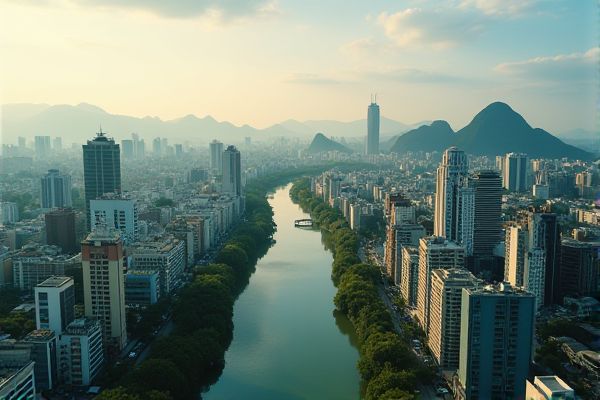
Transportation and commuting in Vietnam: Motorbikes are the primary mode of transport. Traffic congestion common in major cities. Public buses operated in urban areas. Ho Chi Minh City and Hanoi have extensive routes. Rideshare apps like Grab are widely used. Affordable domestic flights for long-distance travel. Train services connect major cities. Roads vary from well-paved to rural paths. Wear helmets when riding motorcycles. Be cautious of traffic laws and local customs.
Motorbikes are the primary mode of transport.
Motorbikes are the primary mode of transportation in Vietnam, with over 77 million registered motorcycles as of 2024. This accounts for 770 motorcycles per 1,000 people and represents around 85-90% of road traffic, driven by their affordability, mobility, and the country's climate and infrastructure. For more detailed insights into this phenomenon, visit the Motorcycle Market In Vietnam expert analysis. This trend underscores the crucial role that motorbikes play in Vietnam’s transportation network, reflecting both economic and environmental factors influencing the landscape.
Traffic congestion common in major cities.
Traffic congestion is a persistent and complex issue in major Vietnamese cities like Hanoi and Ho Chi Minh City, caused by factors such as high population density, urbanization, inadequate Urban Planning, and insufficient transport infrastructure. Despite efforts to develop public transportation and manage traffic flow, these challenges continue to affect daily life and economic productivity. For more insights, visit the Vietnam.vn website to explore the ongoing developments and strategies being implemented to alleviate this growing urban problem.
Public buses operated in urban areas.
Public buses in urban areas of Vietnam, such as Hanoi, include a comprehensive network of subsidized and non-subsidized buses, with the Bus Rapid Transit (BRT) system being a key component. The BRT system, which began operation in 2017, features a 14.7 km route with 21 stations, reducing travel time and promoting sustainable transport, with approximately 14,000 daily users, mostly students and office workers. For more insights into how the BRT system plays a vital role in urban development, visit the C40 Case Study.
Ho Chi Minh City and Hanoi have extensive routes.
In Vietnam, both Ho Chi Minh City and Hanoi boast extensive transportation networks. For train travel, the main railway line, known as the Reunification Express, connects Ho Chi Minh City in the south to Hanoi in the north, stopping at over 20 stations along the way, with additional spur lines branching off to other destinations. For bus travel, both cities have comprehensive bus systems, including local, interprovincial, and sleeper buses, offering affordable and convenient options to explore the cities and surrounding areas. To learn more about train travel options in Vietnam, visit the in-depth guide on the Reunification Express on Vietnam Coracle.
Rideshare apps like Grab are widely used.
Grab is the dominant ride-hailing app in Vietnam, offering car rides, motorbike rides, and food delivery. It is a safe and convenient alternative to traditional taxis, with reasonable fares and various payment options, including cash, credit cards, and e-wallets. For more information, you can visit the Travel Vietnam website.
Affordable domestic flights for long-distance travel.
For affordable domestic flights in Vietnam, consider traveling during the low season (March-April and September-October) and opt for budget airlines like Vietjet Air or Bamboo Airways, which offer competitive pricing and various amenities despite some additional fees for services like luggage and seat selection. For more details, visit Best Price Travel to explore options that fit your travel plans and budget.
Train services connect major cities.
The North-South Railway in Vietnam, also known as the Reunification Express, is a single-track metre gauge line connecting Hanoi in the north to Ho Chi Minh City in the south, spanning 1,726 km and passing through most provinces. This significant railway provides both express and local train services that link major cities and tourist destinations across the country. For more details about this railway line, visit the North-South Railway Wikipedia page, where you can find comprehensive information about its history, development, and impact on Vietnam's transportation network.
Roads vary from well-paved to rural paths.
Vietnam's road network is extensive but varied, with some roads being well-paved, especially the highways constructed and upgraded since the late 1990s. However, many others, particularly in rural areas, remain unpaved or in need of repair. For a comprehensive understanding of the country's infrastructure, visit the detailed description of Vietnam's [Agriculture, Forestry, and Fishing](https://www.britannica.com/place/Vietnam/Agriculture-forestry-and-fishing) on the Britannica website. This highlights the challenges and progress in developing an efficient transportation network that supports various economic activities across the nation.
Wear helmets when riding motorcycles.
In Vietnam, wearing a helmet is mandatory for all motorcycle riders and passengers, with a fine ranging from VND 400,000 to VND 600,000 for non-compliance. The correct way to wear a helmet involves keeping the straps tight and ensuring the helmet fits securely on the head. For more detailed information, you can visit the Lawnet Website which outlines the specific penalties and guidelines for helmet use in the country.
Be cautious of traffic laws and local customs.
When commuting in Vietnam, be cautious of poor road safety, as drivers often do not respect traffic laws, and motorcycles may drive against the flow of traffic or on sidewalks. It is advisable to use official taxis, avoid motorcycle taxis, and drive defensively if you choose to drive. For more information on travel advice and advisories, visit the Government of Canada's Vietnam Travel Advisory website.
